Ringworm is a fungal infections of the skin that can affect both felines and humans. Experienced cat owners, especially those of us with a background in cat rescue, can often recognize the typical round-shaped lesions.
What can you do if Kitty gets ringworm? How to help your feline friend get better and make sure others in your household don't get it too? If you suspect Kitty has ringworm, don't panic.
We're here to help with this detailed guide!
The steps to go through when dealing with ringworm in cats include -
- Talk to your veterinarian and get the diagnosis confirmed.
- Treat the infection using medication prescribed by your veterinarian.
- Consider lime-sulfur dips to help treat severe cases.
- Treat all affected animals and humans at the same time.
- Work to reduce your cat's level of stress
- Thoroughly clean your house to reduce the load of spores.
Ringworm can be challenging to deal with, especially if you have an infestation on your hands, with multiple pets affected.
Educate yourself on this disease but don't panic. Keep reading for a super-detailed guide that will walk you through dealing with ringworm.
Contents
![A female cat looking up toward a light source, How to deal with ringworm in cats [Inc. The Housecleaning Regime]](https://thecatsite.com/c/wp-content/uploads/2014/09/A-female-on-wood-furniture-in-front-of-a-blank-tv-screen-looking-up-toward-a-light-source-How-to-deal-with-ringworm-in-cats-Inc.-The-Housecleaning-Regime-1-533x800.jpg)
What Is Ringworm?
Ringworm is a common name for a fungal infection of the skin. Microsporum Canis is the name of the chief fungus responsible for ringworm in cats.
The outer layer of the skin is made out of a protein called keratin. There are types of fungi - called dermatophytes - that feed off keratin and cause skin infections.
Their spores - microscopic seed-like structures - can be found everywhere around us. Given the right conditions, these spores can germinate and cause a fungal infection of the skin such as ringworm.
Jock Itch and Athletes' Foot are fungal infections of the same type.
Cats can carry ringworm spores without developing an infection. This means the tiny spores may be on their hair, but they don't germinate on the cat's skin, never causing any visible symptoms.
A cat gets an active infection when spores come in contact with the skin itself, find a break in its defense systems, germinate and begin to multiply.
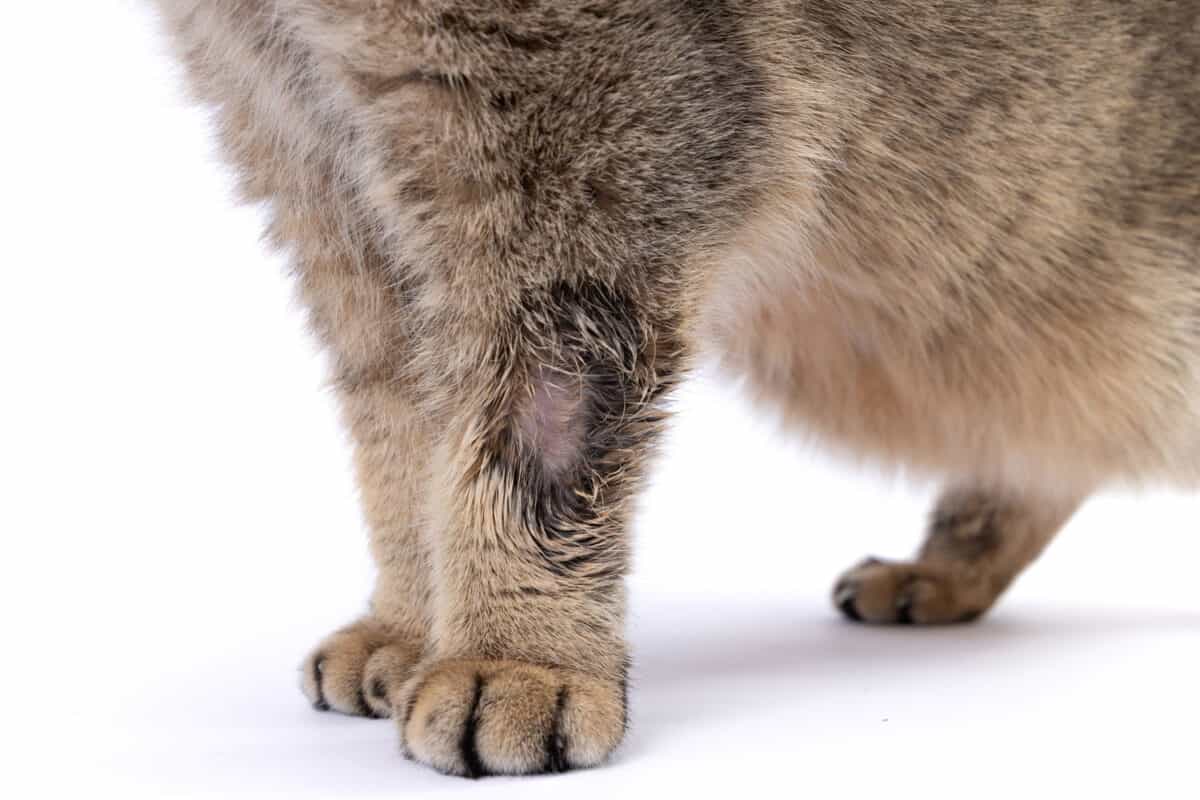
Ringworm is infectious. It can move from cats to humans, and from humans to cats, and between cats (or humans!) Other pets can be infected as well.
Kittens, elderly cats, or those with challenged immune systems are more susceptible to ringworm, although given high enough concentrations of spores, healthy adult cats can also develop the condition.
How Does Ringworm Infect Cats?
A cat can be a carrier of ringworm spores without actually developing an infection. There is a long way for spores to go from dropping on a cat's coat, where it can be cultured, to actually invading its skin and forming an infection.
The cat's first line of defense is self-grooming. Licking the coat is likely to get rid of spores. Once ingested they no longer form a threat, as this type of fungus can only live on a mammal's skin.
The spores that make it through the grooming session still need to get into contact with the cat's actual skin.
That's why lesions often form on the more exposed areas of a cat's body such as the ears and paws. However, even when the spores get to the skin, they still need to find a break in the skin itself in order to germinate.
Even a tiny nearly-invisible break may be enough for them to take root, but without one, they will not be able to form a colony and create an infection. Last, but not least, spores need moisture in order to germinate.
SIGN UP FOR THECATSITE'S EMAIL UPDATES >
Symptoms of Ringworm in Cats
Once a cat is actively infected it develops a lesion at the site of the infection. In mild cases, it can just look like redness of the skin or even dandruff.
In severe cases, it can spread all over the cat's body causing scaly bald patches and itchiness. Typical infections are usually limited to small lesions, usually on the cat's head, ears or legs.
Diagnosing ringworm in cats
Other skin conditions can cause similar symptoms, so only a vet can make the final diagnosis. The traditional test for ringworm is by culturing a sample of the lesion.
This takes up to three weeks of incubation in the laboratory and sometimes yields false results, either positive or negative.
A relatively new way to test for ringworm involves using PCR testing. Samples are sent to a lab that maps out DNA chains and looks for the specific DNA of ringworm pathogens.
Results come in much faster, usually within 1-3 days, and are more accurate. Sometimes additional culture tests may be needed in addition to PCR testing because non-viable spores can cause a false-positive result.
Treating Ringworm in Cats
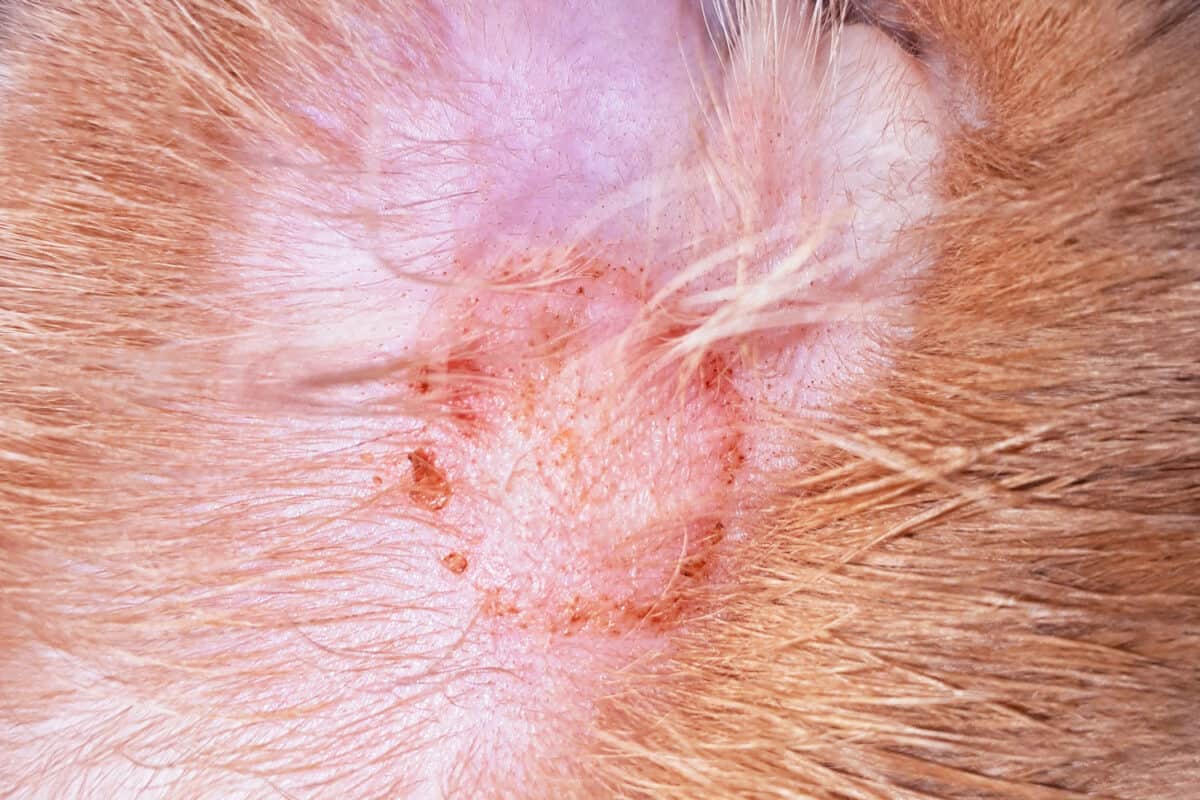
Once the ringworm is confirmed, your vet will prescribe a course of treatment, which can include anti-fungal dips or shampoos and sometimes medication as well.
Work with your veterinarian on finding the best medications to use. Some anti-fungal drugs are very toxic and some are not very effective.
Never use OTC drugs without first consulting your vet (that's always true, for any drug and any medical condition). Be wary of recommendations for specific anti-fungal drugs that you read online.
Take some time to research this or ask around on our Cat Health forums, and discuss the choice of drug with your vet.
Clipping of the cat's fur is sometimes suggested by vets. While it may be necessary in severe cases, clipping has its drawbacks.
Clipping can cause microscopic cuts and bruises to the cat's skin, where ringworm spores can take hold and form new colonies. It can also simply contaminate the treatment room with more spores.
Lime-sulfur dips
Lime-sulfur dips are not expensive and can be a very effective part of treatment. They are usually recommended once or twice a week - consult with your vet about the frequency.
You may be able to find a pet groomer to do them for you, but this won't be easy as many groomers refuse to treat animals with ringworm due to its contagious nature.
Limiting the cat's movement around your home
Limiting the cat's access to certain parts of the home can help with limiting ringworm contamination. It could be a useful step, especially with a highly infected cat and until you achieve some control over shedding using medication and lime-sulfur dips.
Keep in mind that ringworm spores are airborne, so confining a cat to a crate won't help. The spores will get out of the crate and into the room.
Confinement of any kind can increase a cat's level of stress, so use it cautiously and consider taking steps to lower the cat's stress level.
House-cleaning
If you're dealing with a ringworm infestation in a multi-cat household, you will need to decontaminate the house.
Cleaning is your first line of defense, as it helps mechanically move spores out of the house, as well as killing them with disinfectants.
Reducing the number of spores to an absolute minimum prevents re-infection and future outbreaks. We'll cover house cleaning in more depth later in this guide.
Dealing with a Ringworm Infestation
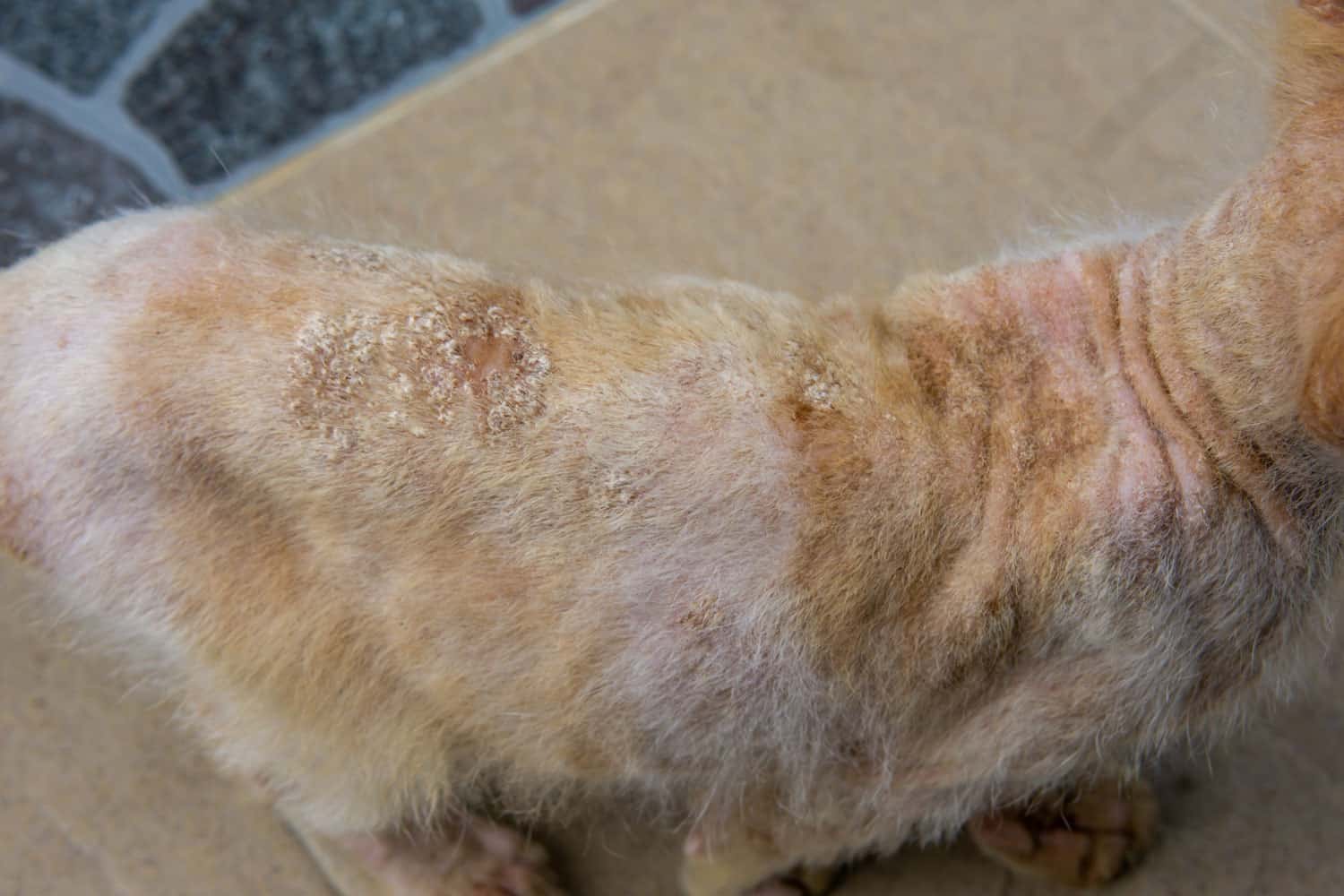
Ringworm can form a special challenge in multi-cat environments where it can transform from the odd lesion on a single cat into an infestation affecting multiple cats.
In such cases, an overall environmental treatment is called for, and owners may find themselves faced with a long and arduous struggle against the invisible fungal spores.
Over the years, many of our members have faced such massive ringworm situations, and one of them, Bunnelina, wrote a great guide about dealing with ringworm.
Some of the tips here were shared by her in this thread where you can read them in further detail and see how our members responded.
1. Educate yourself but don't obsess
Learn about ringworm (you're doing that right now!) but don't obsess. You're all going to be fine!
"Ringworm may be gross, but at least it is not deadly," says Bunnelina.
She suggests taking deep breaths and avoiding over-Googling "ringworm", as you could soon get overwhelmed with information, along with misinformation and useless products for sale.
A good way to get support is by starting a thread in TheCatSite.com's health forum. "I found help, encouragement, kindness, and commiseration here on TheCatSite! Discovering this community was the silver lining of my ringworm odyssey," Bunnelina shared.
If you want to expand your knowledge about the scientific aspects of ringworm and its treatment, watch the video at the bottom of this article.
It's a webcast presented by veterinarian dermatologist Dr. Karen Moriello, DVM, where she thoroughly reviews ringworm, its symptoms, diagnosis, and treatment.
The webcast is directed at shelter workers and addresses issues that are more common in a multi-cat environment.
2. Get going without delay
If you're dealing with a ringworm infestation, time is of the essence. Reducing the number of ringworm spores on your cats and in your household can stop them from germinating and invading new spaces.
What to do if you don't have a final diagnosis yet? Bunnelina suggests starting some treatments right away if your vet suspects ringworm.
"Don't wait for the culture results," she says in the thread."Time's a-wastin' - don't let the spores keep spreading for weeks".
Your vet will probably not prescribe oral medications before the lab results on the culture are in. That's because these medications are toxic and can have some nasty side effects.
Unless there is actual ringworm to treat, medications may do more harm than good.
However, there can be a huge benefit to cleaning your home, and you can also consult your vet about starting lime-sulfur dips.
This substance is harmless to cats and humans but kills ringworm spores, keeping them from spreading through your home.
These dips aren't much fun for the cat though, so do consult your vet and see if he or she thinks the situation warrants them. Your vet can also provide you with instructions about the right way to perform the dips.
3. Clean A LOT
Your goal is to reduce the number of ringworm spores in the environment. The larger the number of spores, the more likely is a few of them to get past the body's defense mechanisms and cause the disease.
4. Treat all animals at once
Concentrate your efforts and attack ringworm from every angle at once. Do everything at the same time, for both animals and humans who may be infected.
This means oral medications as prescribed by your vet after the diagnosis, topical cream, and dips for everyone together.
At the same time, keep cleaning your house, so that you're attacking the monster from every angle.
Have your cats checked for fleas and mites as well, and treat accordingly, as these parasites cause microscopic skin injuries where ringworm can take hold.
Make sure the environment isn't too damp, and keep things decluttered and clean.
Fighting Ringworm: The Housecleaning Regime
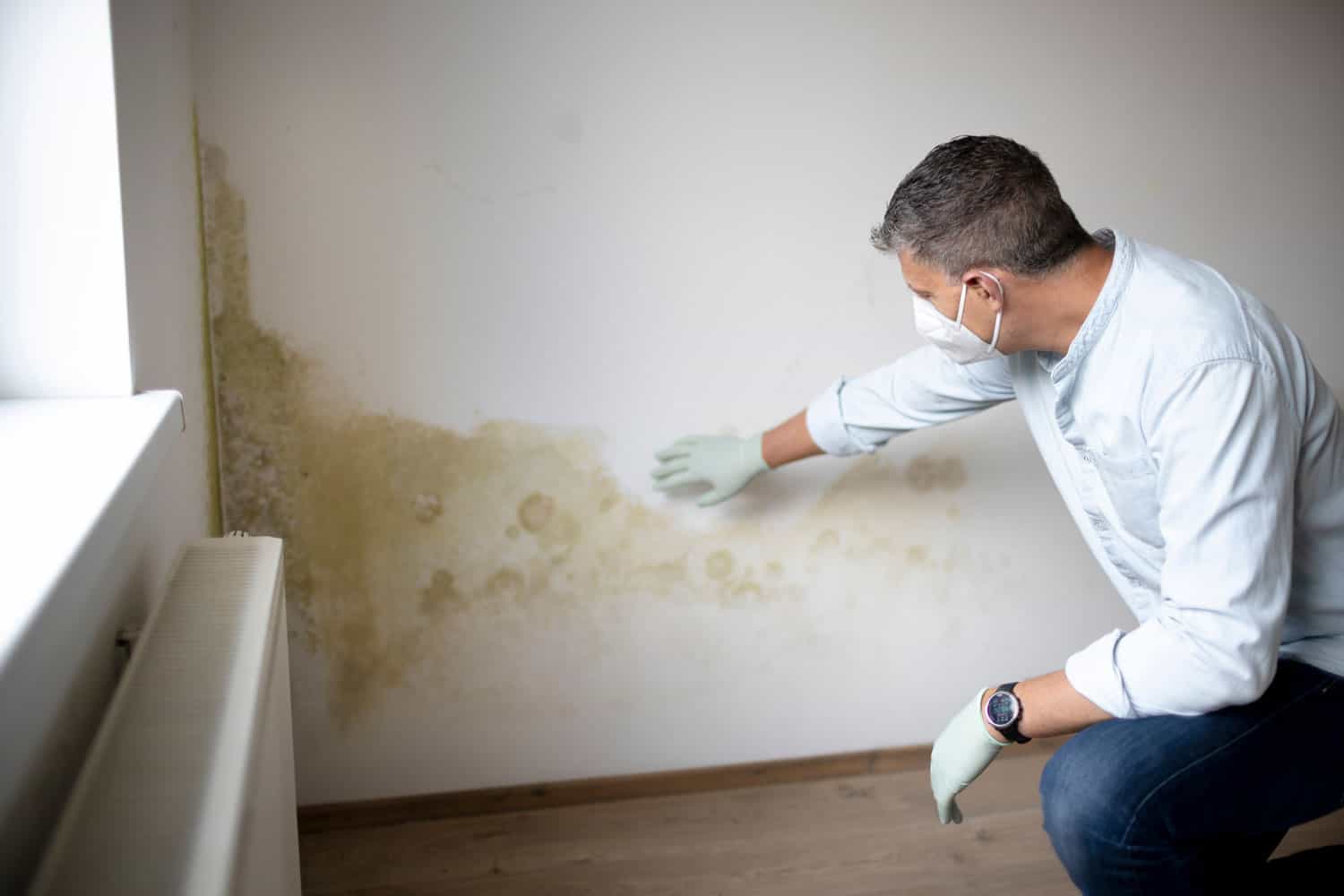
This special guide deals with one aspect of treating a ringworm infestation: housecleaning. It is essential in fighting ringworm infestations in multi-cat environments.
The information in this article is based on advice by veterinarian dermatologist Dr. Karen Moriello, DVM, DACVD, an expert on treating ringworm in shelter environments.
Some of the cleaning tips here are from the epic ringworm thread started by TCS member Bunnelina.
The Goal of Housecleaning
The good news is that you are not trying to sterilize your home or make it 100 percent spore-free. There will be some shedding as long as there's an infected animal (or human) in the house, but the fewer the spores, the less likely are the cats to become re-infected.
Eventually, you will probably need to clean your whole house, because ringworm spores are airborne. But you can do it in stages.
It will take a lot of effort in the beginning and then you’ll just need to do maintenance cleaning as you wait for your cats to be cured.
Bunnelia suggested in her thread that you think of this as fighting dust mites or other allergens.
You know you'll always have some, but if you're allergic you aim at reducing their presence to a minimum, knowing you can never entirely eliminate them.
Another piece of good news is that spores do not multiply on their own. Unlike mold, the invisible spores of ringworm cannot grow in numbers while they're in their house.
Only active infections shed new spores into the environment. Once the spores are out there, they need to germinate on the skin in order to produce new spores.
Housecleaning can be beneficial in other ways too. “I was SO worried when I learned our cats had ringworm," says Bunnelina. "But I found cleaning to be the perfect distraction.
Fear and anxiety gave me loads of nervous energy to keep going with cleaning tasks that I’d normally hate doing. So if you’re feeling anxious, don’t sit there —clean!
It will distract you and soon you’ll feel productive and in control instead of helpless. You’ll probably be surprised at how much you accomplish.”
What Should You Be Cleaning?
The fewer surfaces you deal with cleaning, the easier it is for you to battle ringworm. Your first step is de-cluttering your household.
Keep things realistic — you're still living there! — but this could be a good time for spring cleaning and for storing unused items out of sight.
Just make sure you clean them properly prior to storage so you can get them out later without re-contaminating your house.
Textiles such as carpets, curtains, and furniture covers are prime dust and spores locations. Cat trees and gyms belong in this category unless they're made exclusively from plastic or a similar surface that can be wiped clean.
The more textiles you can remove, sanitize and store for the duration of Operation Ringworm, the better.
Don't forget to clean them thoroughly before storing them. Steam cleaning, laundering in hot water and a hot dryer, or dry-cleaning are best. People on the forum recommend a laundry additive that contains triclosan (sold as Vibax).
As for your furniture, Bunnelina suggests covering them with lightweight bed covers which can easily be washed and dried to be cleaned.
Even plain sheets will do the job. Remember, this is just temporary - you will be getting your old living room back!
Anything else that stays in your house and could possibly come in touch with dust and/or cat hair will have to be cleaned on a regular basis.
Keep it as simple, de-cluttered, and as textile-free as possible. Pack away knickknacks and other items after you wash them or wipe them down.
Use a damp microfiber cloth, which can catch and hold the spores, and rinse it out frequently.
You can use make a cleaning solution with the laundry additive (read the directions on how to dilute) or another disinfectant (see below).
Cleaning Procedures
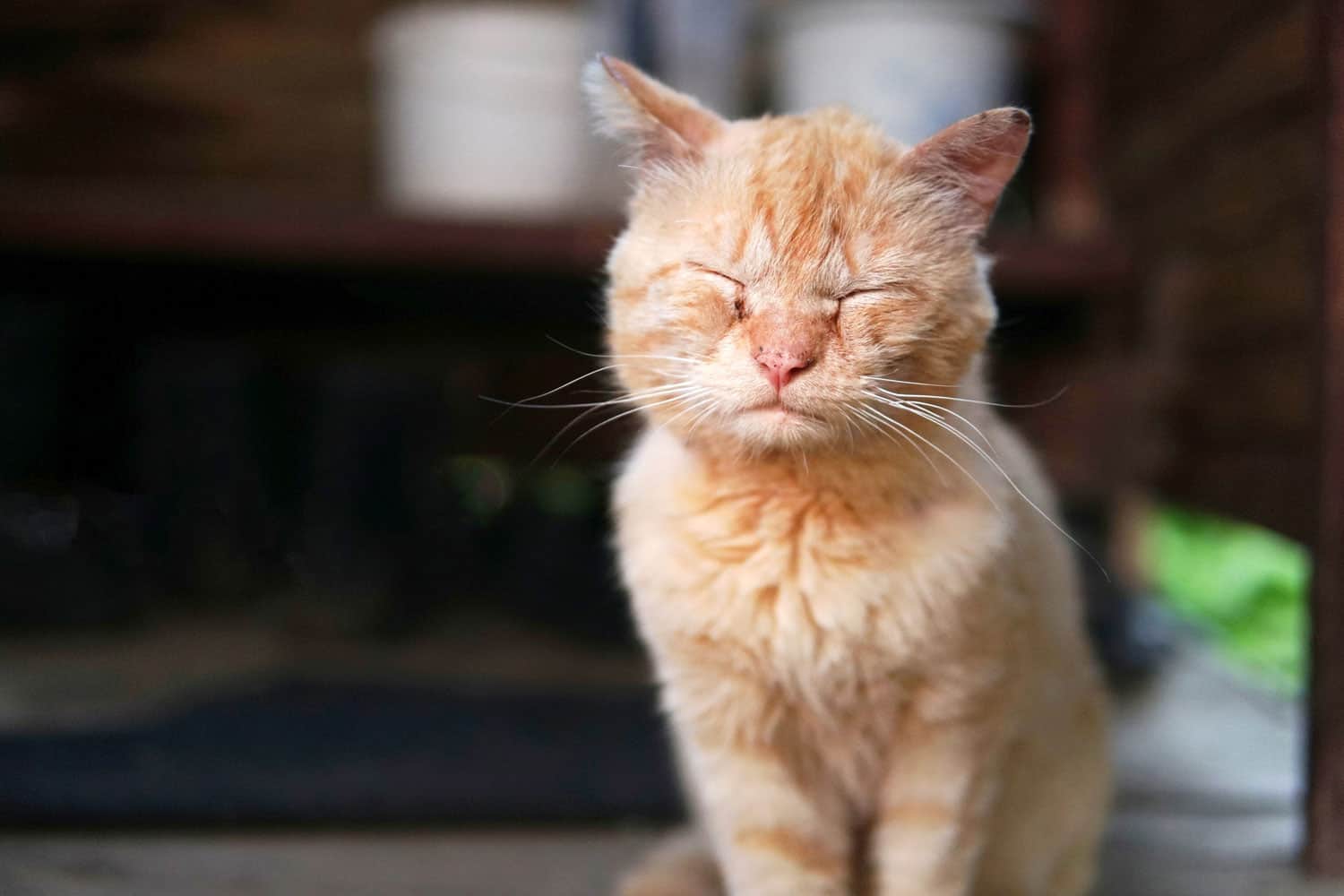
Get rid of cat hair and anything that "looks dirty." Dirt and debris such as "dust bunnies" and loose hair cats act as shelters for ringworm spores, protecting them from detergents and disinfectants.
You can't just clean around them. You have to get rid of them first. A Swiffer-type mop with disposable cloths works well for wiping floors, walls, windows, doors, and ceilings.
Like microfiber cloths, it will trap dirt and particles. Change cloths when you see they’re getting dirty.
Two-Step Cleaning Process: Detergent then Disinfectant
Dr. Moriello suggests washing surfaces with water and detergent first, allowing them to dry before applying a disinfectant.
The idea is to mechanically remove most of the spores out of your home, and only then to exterminate the ones that couldn't be vacuumed, swept, or wiped away.
Applying disinfectant on wet surfaces is less effective, so you have to clean thoroughly, rinse with water, dry thoroughly, and only then apply the disinfectant.
Choosing the Right Disinfectant
As to which disinfectant to use, again, advice shared on our forums suggests using a laundry additive containing Triclosan (sold as Vibax).
Dr. Moriello says other disinfectants can work well too, as long as they were tested against trichophyton mentagrophytes (a type of fungus that's similar to the one causing ringworm).
Use disinfectant liberally and let it stand for at least 5-10 minutes, to allow the active ingredients time to break down the spores and kill them.
You may have read that a strong bleach solution works best to kill ringworm spores but not many surfaces in a home can handle that treatment, and the fumes can be unhealthy for your family and your cats.
You can use a diluted bleach solution on things like plastic cat carriers and tile floors if you prefer, but focus your efforts on wiping, vacuuming, and using less-toxic cleaners.
Safety Precautions
Make sure your cats and other pets do not come in contact with your cleaning products, which might be toxic. Rinse floors and other surfaces with plain water to keep everyone safe.
Fight dust wherever it may reside in your household. Wipe surfaces with a damp cloth and use sanitizing cleaning solutions wherever possible.
Dust and dry-swiffer every day and don't forget surfaces such as walls, doors, windows, and the ceiling. Mop the floors at least once a week, or as needed.
If your cat has been underneath beds or upholstered furniture, it’s important to vacuum the undersides of those, too.
The Vacuum Cleaner
The vacuum cleaner is your chief ally in cleaning. You need a good one that has a HEPA filter to sift particles as small as fungal spores.
Some sources recommend getting a cheap vacuum cleaner with disposable bags, changing the bags daily, and getting rid of the vacuum cleaner itself when you're rid of the ringworm.
However, TCS member Bunnelina recommends a different approach. She believes the cheaper cleaners suck in the spores and blow some of them back into the air via their exhaust.
She opted to invest in a quality vacuum cleaner, a Miele in her case, with self-sealing bags and a quality HEPA filter. The self-sealing bags make sure none of the dust and spores get back into the air, in effect purifying the room.
Click To View This Miele Vacuum Cleaner On Amazon
How Long Will This Last?
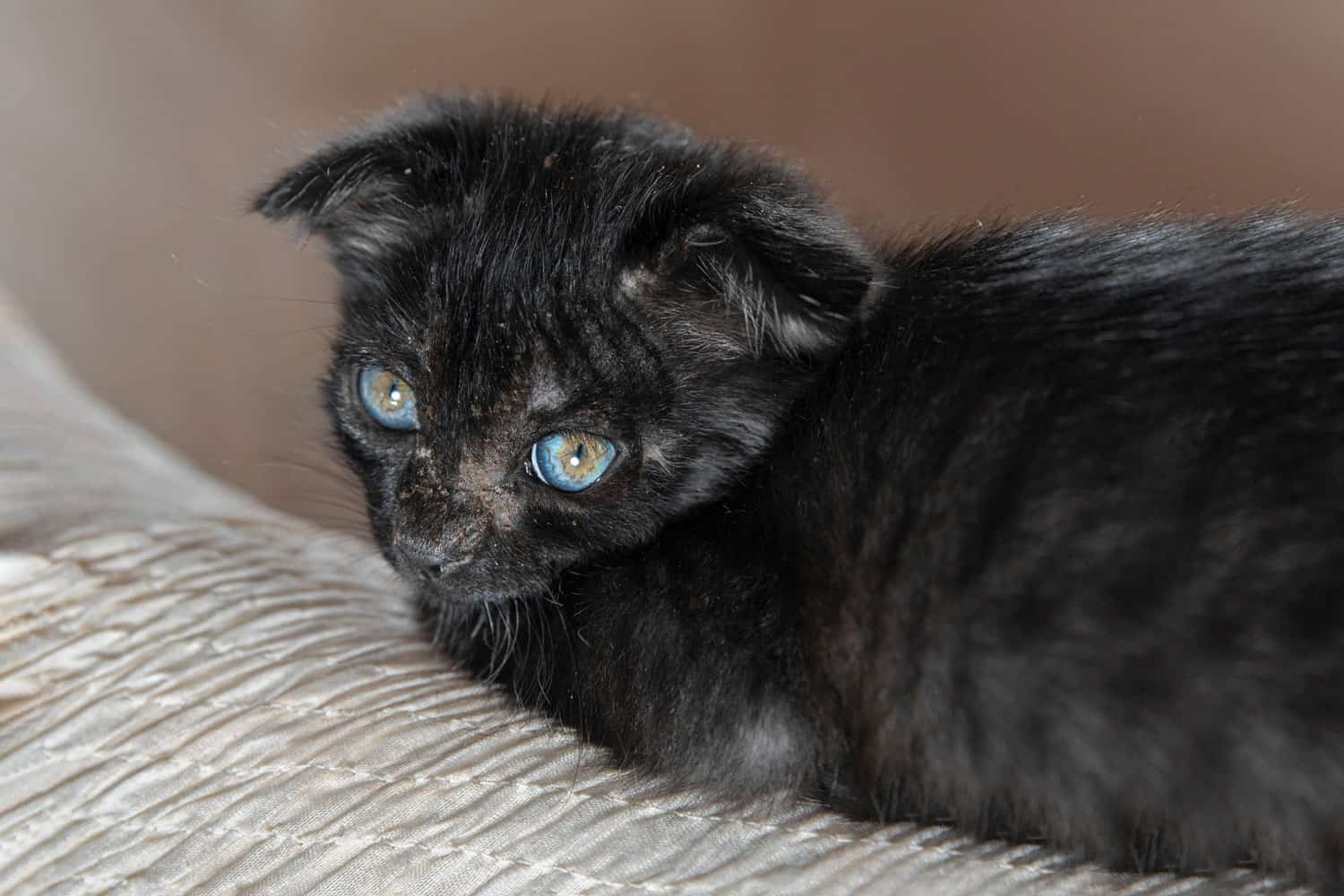
The good news is that this cleaning fest is temporary. Consider this as Operation Ringworm and remember that there is light at the end of the tunnel!
You want to get the ringworm spore levels down while your pets are being treated so that they do not keep getting attacked by new spores.
It is the infected pets who actually shed fresh spores into the environment, so cleaning alone won't do the trick. It's a vicious cycle that you need to break by cleaning the house and treating the pets at the same time.
You should plan to keep on cleaning intensively until your cats start getting negative culture results. Then you can relax a bit, but keep on fighting against dust and fur building up anywhere.
Once your pets are all healed, they stop shedding new spores. If your house is clean enough at that point, and spore levels aren't high enough to ignite a new infestation, you're in the clear!
Just how long it would take depends on many factors: the number of sick pets, the effectiveness of treatments used, the level of cleanliness you achieve — and sheer luck!
SIGN UP FOR THECATSITE'S EMAIL UPDATES >
Finally, here is the video webcast by Dr. Karen Moriello. It's not short and a lot of it is intended for shelter workers, but if you have a ringworm infestation on your hands, it's a great resource that's well worth watching.
Many of our members have dealt with - and beaten - ringworm.
If you're not a member yet, make sure to join our community of cat lovers, so you can post about your own battle with ringworm and get advice and support from other members too.
Got ringworm questions? Please use the cat health forum for those!
Note: We may get commissions for purchases made through links on this page.


.jpg)

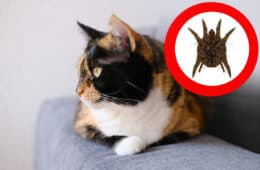
13 comments on “How to Deal with Ringworm in Cats [Inc. the Housecleaning Regime]”